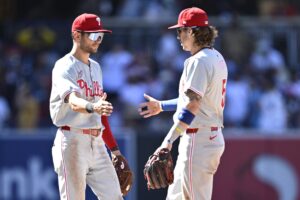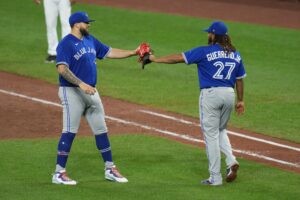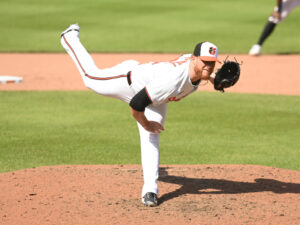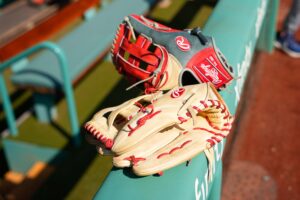Carson Kelly and the Mindset Change That Sent His Career to New Heights
Arizona Diamondbacks catcher Carson Kelly left a positive mark on his new team in 2019. In 111 games, he had slashed .245/.348/.478, going 77-for-314 with 19 doubles, 18 home runs, 47 RBI, and 46 runs scored. This translated into a .359 wOBA and 11.9 weighted runs above average (wRAA). In other words, the Diamondbacks scored almost 12 more runs by having Kelly at the plate instead of the average hitter in the league from 2019.
Going into 2020, he had a positive spring before everything shut down. When he returned, he had a sluggish start to the season. He was on pace for a career low in offensive production. However, over the final two weeks, he turned it around. This hinted that 2021 could be a breakout year for Kelly, and so far — despite the injuries — it has been.
Carson Kelly Arrives with the Diamondbacks
Carson Kelly joined the Diamondbacks December 5, 2018. He came over from the St. Louis Cardinals in a trade — Kelly, pitcher Luke Weaver, infielder Andrew Young, and a 2019 competitive balance draft pick in exchange for the face of the franchise, first baseman Paul Goldschmidt. When Kelly initially heard he had been traded — having “no idea,” in his words, that Goldschmidt was the one going to St. Louis — he was “very excited. (But) it was bittersweet. The guys in St. Louis drafted me, brought me up, and gave me the opportunity to be a professional baseball player. But at the same time, I thought, ‘This is an opportunity for me to go out and play. (To) get to an organization that — hey, they want you. They traded for you.’”
Kelly continued, “Seeing that, and talking with (manager) Torey (Lovullo) and Haze (general manager Mike Hazen), those guys said, ‘Just go be you, man. Be you.’ I’m a highly cognitive guy, so for me, I almost need to take a step back and say, ‘Just go play!’ Because I like to think. I think, think, think, think. ‘What’s wrong? How do I do this, do that?’ That’s just how I am. So for me to be at my best, I almost need to take a step back.”
Hearing about the Return
When he finally heard that he had been traded for Goldschmidt, it was “pretty cool. Seeing how much Paul meant for this organization, the type of player he is, the type of person he is — seeing that, and knowing what I got traded for, is cool.”
It can be daunting for a player who gets traded for a franchise icon, but Lovullo and Hazen squashed that before it could even enter Kelly’s head. “Part of the message that I had when I first got traded was that I’m never going to be Paul Goldschmidt,” Kelly explained. “I’m never going to be able to replace Paul Goldschmidt. But I can be the best person I can be to help this team win, to be a part of this organization, and to be a part of this city. And that’s something I still believe today, even three years down the road.”
Plate Approaches
Coming into 2019, Kelly was searching for consistency. “Every year, you’re always trying to figure out, as a player, how to be more consistent at the plate. In ‘19, (I had) the opportunity to fail, succeed, and go through everything, (and I found) my groove in that,” he said. “Going into ’20, I thought, ‘Okay. I’m going to do the same thing I did in ’19.’ It wasn’t a complacent thought, but I never really challenged myself. Obviously, with spring training being short, and the COVID and everything like that, it was hard to find ways to keep growing. For me, that was tough.”
Coming back, “we had 60 games, so we thought, ‘We’ve got to go, right away.’ The mindset was ‘have to.’ Have to do things. I need to do things, versus ‘I’m just going to go play.’ When you put in that extra, added pressure, you don’t perform as well.”
Change in Mindset
Carson Kelly was not alone in the rough start to his 2020 season. Entering it with the mentality of having to get things going immediately caused the whole team to press. When the Diamondbacks hit a losing streak out of the gate, they pressed more, and it turned into a vicious cycle. For Kelly, his offensive numbers through September 12 were .183/.232/.301 (17-for-93) with two doubles, three homers, 11 RBI, six walks, and five runs scored. His wOBA was .234, translating into -7.2 wRAA.
It all changed at that point. For the final 12 days of the season, he batted .345/.367/.655 (10-for-29) with three doubles, two home runs, and six runs scored. This translated into a .417 wOBA and 2.4 wRAA — again, 2.4 runs over a span of 12 days. It came largely from a change in mindset at the plate — one of not worrying so much about the outcome. “If you get out, you get out; if you don’t, you don’t,” he said. “Avoiding (thoughts of) ‘I went 0-for-4. Am I going to go 0-for-4 tomorrow?’ It was more of a mindset thing for me.”
Simple in Theory, Tough in Practice
That mindset was simple in theory, but tough in practice — avoid chasing results. “When you chase results, your focus is on something that is out of your control,” Kelly said. “You can hit the ball hard at the second baseman, or you can hit it four feet to his right and (end up with) a hit versus an out. Why are you going to be upset about it?”
Kelly said that major league players — including him — forget “all the time” that they play a sport where failing seven out of ten times — batting .300 — is considered good. “Every single player holds himself to a high standard. But the players who stay in the big leagues for a long time and continue to get better every year trust what they do, and (trust that) their work is going to produce results.”
“Find Things You Can Control”
Baseball teams compete with their opponents. On the other hand, baseball players compete with perfection. This can be both good and bad, but Kelly knows the way to keep this competition as a positive. “As players, we always strive to be perfectionists, but we have to have the understanding that we’re never going to be perfect. To do that, you have to find things you can control. What can I control? I’m going to practice this way. My mindset is going to be this way. And the result will happen over the course of time.”
Perfectionism can make someone afraid to fail, and this is something Kelly takes care to avoid. “If you put so much emphasis on ‘this has to be perfect. Oh, I messed up there!’ and dwell on that, it’s going to be hard to keep going. So learning that as a player — not riding the highs so high and the lows so low by finding the middle — will make you better off in the long run.”
Moving Ahead
With the new mindset in place, Kelly made “a lot of swing changes” in the offseason. “(I was) simplifying things, getting my swing to a point where I can repeat it every single time without an extra thought. What that allowed me to do was take these waves (tracing a large soundwave in the air) — we talk about ‘riding waves,’ as players — and make them smaller waves,” he said, bringing his hands from far apart to close together to illustrate his point. “So you’re staying more on a linear scale than having these big droughts and these big successes.”
Carson Kelly started 2021 with a bang, batting .338/.491/.613 (27-for-80) through the end of play on May 13. He had four doubles, six homers, 19 RBI, 23 walks, 16 strikeouts, four HBP, and 16 runs scored — a .468 wOBA and 13.9 wRAA. Then the news came out that a foul ball caused a fracture of his left big toe. Consequently, he missed 10 games. His batting average fell after he returned, but even still, he was batting .260/.385/.460 (39-for-150) when he broke his wrist June 19 against the Los Angeles Dodgers. He also has six doubles, eight homers, 26 RBI, and 22 runs scored for a .370 wOBA and 8.8 wRAA. Although it isn’t what it was, that’s still far better than most catchers.
Returning from the Injury
Maintaining offensive production is difficult when returning from injury, and Kelly was no exception. However, the mindset change from 2020 helped him greatly with something. “Going through (the mindset change in ’20) has put me in the position I am today, where even though I’ve been hurt, I’ve still been able to do the same swing — the same movements — that I did two weeks before I got hurt,” Kelly said. “Finding ways to be consistent with those movements has helped me make better decisions on swings, to see the pitch longer, and to be as consistent as I can in the box.”
The Big Picture for Carson Kelly
Carson Kelly has the chance to be one of — if not the — best catchers in the history of the Arizona Diamondbacks franchise. They’ve had a grand total of two All-Stars at that position — Miguel Montero and Damian Miller. Montero made the squad in both 2011 and 2014, while Miller made it in 2002. Kelly was on track to make the squad in 2021 before getting injured.
But Kelly does not think about his long-term legacy. “I want to take it day by day — be the best that I can be today. I’ve got to keep learning. There are things I haven’t experienced yet that can happen in three years that either might be better for me in my career or worse for my career. There are things that are out of your control. So what I can do is focus on what I can do right now, and all that other stuff will take care of itself.”
Despite having both a broken toe and a broken wrist, he has a positive mindset. “During these times of being hurt, it’s given me perspective. There’s still a lot to accomplish — still a lot to grow from, still a lot to experience. And that I take as a challenge and as an opportunity, because not everybody gets to play in a big-league uniform.”
Main Photo:
Embed from Getty Images
Players mentioned:
Carson Kelly, Luke Weaver, Andrew Young, Paul Goldschmidt, Miguel Montero, Damian Miller






